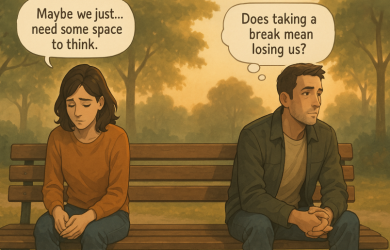9 Thirst Trap Boundaries Every Couple Should Discuss

Unlock Daily 30-Sec Tips for a Happier Relationship
👉 Subscribe FREEKey Takeaways
Marriage.com AI Quick Summary
It starts as something light—maybe a confident selfie, a gym pic with just the right lighting, or a playful post that says, “I know I look good today.” But somewhere between the likes, the fire emojis, and that one unexpected comment, things can feel… off.
Is it just fun, or is it attention-seeking?
Is it harmless, or is it disrespectful?
Social media doesn’t come with a guidebook, and when love enters the mix, the lines get blurry fast. One partner might laugh it off; the other might quietly spiral.
What feels like confidence to one can feel like rejection to the other. And that’s where things get tricky. Thirst trap culture isn’t just a trend—it’s a tension waiting to be named.
What is a thirst trap in a relationship?
A thirst trap isn’t always about being scandalous or seeking validation from strangers—it can be as simple as posting a confident photo, knowing it’ll turn heads. In a relationship, though, it can stir up a mix of emotions: pride, insecurity, confusion, and even hurt.
Maybe it’s playful; perhaps it crosses an emotional line. That’s why understanding the thirst trap meaning within your relationship matters. What feels empowering to one person might feel unsettling to the other.
And it’s not about blame—it’s about figuring out what feels safe, respectful, and real for both of you.
9 thirst trap boundaries every couple should discuss
Even in the happiest relationships, it helps to talk about the things that feel small on the surface but carry weight underneath. A thirst trap might seem playful or even empowering, but in love, context is everything.
What one partner considers “no big deal” might quietly sting the other. That’s why setting gentle, mutual boundaries around posts like these can protect not just feelings but connection, too.
1. Is posting thirst traps okay in the relationship?
Some people see thirst traps as a form of self-expression or self-love; others view them as public flirtation. If one partner thinks it’s totally fine and the other doesn’t, it’s easy for wires to cross.
Talking about this upfront can reduce confusion, hurt, or resentment later on. It’s not about shutting someone down—it’s about checking in.
Is it okay with both of you?
Or does it bring up feelings neither of you expected?
-
Why does it matter?
Assumptions can quietly erode trust, especially around public image and attention. Clarifying this boundary helps both partners feel considered and safe.
When you agree on what’s okay, you reduce room for misunderstandings and show that you’re both invested in emotional honesty—even around something as seemingly casual as a selfie.
Here’s how to talk about this:
- “What kinds of posts feel okay to you when you’re in a relationship?”
- “Do you feel different about it when someone’s single vs. partnered?”
- “Would you ever feel hurt or weird if I posted something bold?”
2. What counts as a thirst trap for us?
What feels “thirsty” to one person might feel entirely ordinary to another. A gym mirror picture, a sultry selfie, a flirty caption—context matters.
Each couple will have different thresholds, and that’s perfectly okay. The important thing is that you both agree on what counts. Talk it out, name examples, even laugh about it—clarity makes space for ease.
-
Why does it matter?
When you’re on the same page about what a thirst trap looks like, there’s less emotional guesswork. Defining it together creates a shared language, which builds emotional closeness.
Research indicates that words expressing positive emotions predict relationship satisfaction, while first-person plural words relate to partner closeness. High-quality relationships feature linguistic certainty, inclusiveness, and expressiveness, whereas anxiety-related language signals inhibition. These findings highlight how language reflects and shapes the quality of romantic relationships across multiple dimensions.
No one feels blindsided or judged, and you both feel like you’re on a team, not opposite sides of a blurry line.
Here’s how to talk about this:
- “Let’s show each other a few posts—what feels like a thirst trap to you?”
- “Would a mirror selfie in gym clothes count for you, or not really?”
- “Are captions part of what makes it feel flirtier or more attention-seeking?”
3. Should thirst traps be shared privately or publicly?
Some people love the thrill of posting something bold; others feel more secure when those moments stay private. There’s no right or wrong—just what works best for your relationship.
Maybe a partner is fine with sexy pictures, but only in DMs or texts. Or maybe public posts are okay, but with agreed-upon limits. It’s all about intention, trust, and context.
-
Why does it matter?
Deciding whether these photos live online or stay between the two of you helps balance confidence with care. Private sharing can feel more intimate, while public sharing is more exposed.
When you’re intentional about where the line is, it becomes less about control—and more about shared respect and emotional safety.
Here’s how to talk about this:
- “Do you feel any difference between posting publicly vs. sharing just with me?”
- “Would you rather I send these to you directly instead of posting them?”
- “How do we both feel about attention from strangers online?”
4. Are certain platforms off-limits for these posts?
Instagram might feel more casual than LinkedIn, but what about Snapchat? TikTok? Threads?
Each platform has a different vibe and a different audience. Maybe one space is where you share your “hot” side, and another is strictly for close friends. It’s worth talking about what platforms feel okay, and which ones feel too public or too performative.
-
Why does it matter?
Every platform invites a different level of attention and response. Setting boundaries here isn’t about censorship but honoring comfort zones.
Knowing which digital spaces feel safe helps you protect each other’s emotional well-being without needing to micromanage or guess.
Here’s how to talk about this:
- “Which platforms feel more personal or private to you?”
- “Are there any places where you’d rather I didn’t post certain photos?”
- “Should we treat close friends lists or private stories differently?”
5. How do we handle likes and comments on thirst traps?
A fire emoji here, a flirty “Damn heart-eyes” there… comments can add unexpected heat. While you can’t control others, you can control how you respond—or whether you even allow comments.
It’s also worth checking how likes and compliments from exes, flirty followers, or mutual friends land emotionally.
Do they feel innocent or invasive?
-
Why does it matter?
Social validation can be addictive, but it can also chip away at a partner’s sense of emotional safety.
Setting expectations around replies, DMs, and reactions makes it easier to stay present with each other. It helps create boundaries between healthy attention and hurtful ambiguity.
Here’s how to talk about this:
- “How do you feel when people leave flirty comments on my posts?”
- “Would it help if I limited comments or turned them off?”
- “Should I reply to those comments—or just let them sit there?”
6. Is it okay to react to other people’s thirst traps?
We live in a world of double taps and heart emojis. Still, those tiny digital gestures can mean a lot in relationships.
If you’re scrolling and liking someone else’s thirst trap, it might not seem like much to you, but to your partner, it could feel like a breach of trust or attention. It’s a subtle but powerful thing to discuss.
-
Why does it matter?
Where you place your attention—especially online—can affirm or erode your partner’s sense of connection.
Agreeing on this helps prevent quiet feelings of comparison or inadequacy. It’s a way of saying, “Your comfort matters more than a passing moment of flattery.”
Here’s how to talk about this:
- “Do you feel weird if I like someone else’s bold photos?”
- “Is there a difference between liking and commenting?”
- “Would it bother you if I followed certain types of content?”
7. How should we handle past thirst traps that are still online?
Maybe you posted something bold before the relationship began, or during a rocky time. Old thirst traps can stick around long after feelings change.
Do they stay up?
Get archived?
Talked about?
It helps to be honest about how you both feel when those old posts resurface.
-
Why does it matter?
Digital history doesn’t fade unless you choose to change it. Addressing the past gently shows your partner that you’re willing to prioritize the relationship’s present over old attention.
It’s not about erasing who you were, but aligning with who you are now together.
Here’s how to talk about this:
- “Would it make you uncomfortable if I left those older posts up?”
- “Do any of my past photos feel too out there now that we’re together?”
- “Should we go through them and decide what still feels okay?”
8. What’s the intention behind posting: fun or flirt?
Sometimes, a thirst trap is just a playful “I feel good today!” But sometimes… it’s fishing for outside validation or low-key signaling to someone specific. Checking in on the why behind the post brings a lot of emotional clarity.
Are you posting for fun, self-love, boredom, or something else?
Intention changes everything.
-
Why does it matter?
Being honest about motives fosters emotional transparency. When both of you feel safe being real—without fear of judgment or shame—you create space for trust.
And when trust is present, even bold posts don’t feel threatening… because the “why” is rooted in honesty, not secrecy.
Here’s how to talk about this:
- “When you post something bold, what are you hoping to feel afterward?”
- “Would you tell me if you posted something because you were feeling low?”
- “Do you ever feel like you need outside validation to feel attractive?”
9. What happens if one of us feels hurt or uncomfortable?
Even with boundaries, feelings will occasionally bubble up. That doesn’t mean someone did something wrong—it just means it’s time to talk.
Make space for one another’s feelings without defensiveness. “This made me feel a little off” is just as important as “I didn’t mean anything by it.” The goal isn’t to win—it’s to understand.
-
Why does it matter?
Having a plan for emotional check-ins keeps small wounds from turning into big resentments. It shows that feelings are welcome, not punished.
And that kind of emotional safety?
It’s the true boundary that keeps your relationship strong, not fragile.
Here’s how to talk about this:
- “How would you want me to bring it up if something online made me feel uneasy?”
- “What would help you feel seen when you’re feeling uncomfortable?”
- “Can we both agree that it’s okay to revisit boundaries as we go?”
Why do thirst traps affect relationships?
Thirst traps can stir up more than just likes. In a relationship, they might trigger feelings that surprise even the person posting—jealousy, insecurity, pride, confusion… or all of them at once. What feels empowering to one partner might feel unsettling to the other.
And sometimes, it’s not the photo—it’s the comments, the timing, or who it seems aimed at. It’s less about the picture and more about the unspoken impact.
Here’s why they can hit a nerve:
- They invite attention from outside the relationship
- They can blur emotional boundaries
- They may trigger past trust wounds
- They sometimes signal unmet needs
When feelings are left unspoken, thirst traps can quietly chip away at connection. But when they’re talked about, they can actually open space for honesty, reassurance, and deeper trust.
Can thirst traps be healthy for love?
Not all thirst traps are red flags. In some relationships, they can actually add playfulness, self-confidence, or even intimacy. It all depends on the intent, the communication, and how both partners feel about it.
When used with care—not secrecy—thirst traps can create unexpected moments of connection, not conflict.
1. They can boost self-confidence
Posting a thirst trap when you’re feeling good can reinforce body confidence and self-acceptance. It’s a way of saying, “I feel like myself today—and I like what I see.”
That kind of energy can ripple into the relationship, too. Confidence often invites closeness, not distance.
- A little secret: When someone feels secure in their skin, they often show up more lovingly in their relationship, too.
2. They can create playful flirtation
When done with respect, thirst traps can actually keep the spark alive. A cheeky post might become an inside joke or a flirty moment between you two.
Sometimes, it’s less about the internet and more about knowing your partner still finds you irresistible.
- A little secret: Playfulness in love isn’t childish—it’s what keeps things from going stale.
3. They can invite honest conversations
The moment a thirst trap stirs up feelings, there’s a chance to talk, not accuse.
These conversations can bring up deeper truths about comfort, validation, or past hurts. And the more open you are, the more trust you build.
- A little secret: Every awkward moment can either close a door or open a window—you get to choose.
4. They can be part of shared boundaries
In some couples, thirst traps are totally okay—because the rules are clear and mutual. Boundaries don’t have to mean restriction; they can actually be freeing.
When you both know what’s cool and what’s not, you relax into the relationship with less tension.
- A little secret: Boundaries aren’t about keeping each other in—they’re about keeping the connection strong.
Watch this video, in which Emma McAdam, an LMFT, explains what often prevents people from setting healthy boundaries and shares one essential key to doing it well:
5. They can affirm individuality through love
A thirst trap doesn’t have to mean “I’m looking elsewhere.” Sometimes, it just means, “I still feel like me.”
In a secure relationship, celebrating individuality is part of what keeps love alive, because you’re choosing each other, not losing yourselves.
- A little secret: The healthiest relationships leave space for “we” and “me” at the same time.
Build trust, not tension
Every couple has their own rhythm—what feels playful, what feels personal, what feels like too much. Thirst traps don’t have to be deal-breakers; they can be door-openers. The key isn’t control—it’s clarity.
When you talk through these little things with care, you make room for honesty, laughter, and even a few surprises. You don’t need to overanalyze every post or scroll in fear—just stay curious about how your partner feels and keep checking in.
Boundaries aren’t about shutting each other down—they’re about holding the relationship gently so it can grow without guesswork or quiet hurt.
 Tips
Tips
Write your tip or submit a video tip
All tips are reviewed before the publishing.
Share this article on
Want to have a happier, healthier marriage?
If you feel disconnected or frustrated about the state of your marriage but want to avoid separation and/or divorce, the marriage.com course meant for married couples is an excellent resource to help you overcome the most challenging aspects of being married.
Recent Articles
Related Quizzes
Unlock Daily 30-Sec Tips for a Happier, Healthier Relationship
👉 Subscribe FREE on YouTube We'd love your feedback!
We'd love your feedback!
 Expert Q&A
Expert Q&A
Ask your question related to this topic & get the support you deserve from experts.



















 Thanks for your feedback!
Thanks for your feedback!